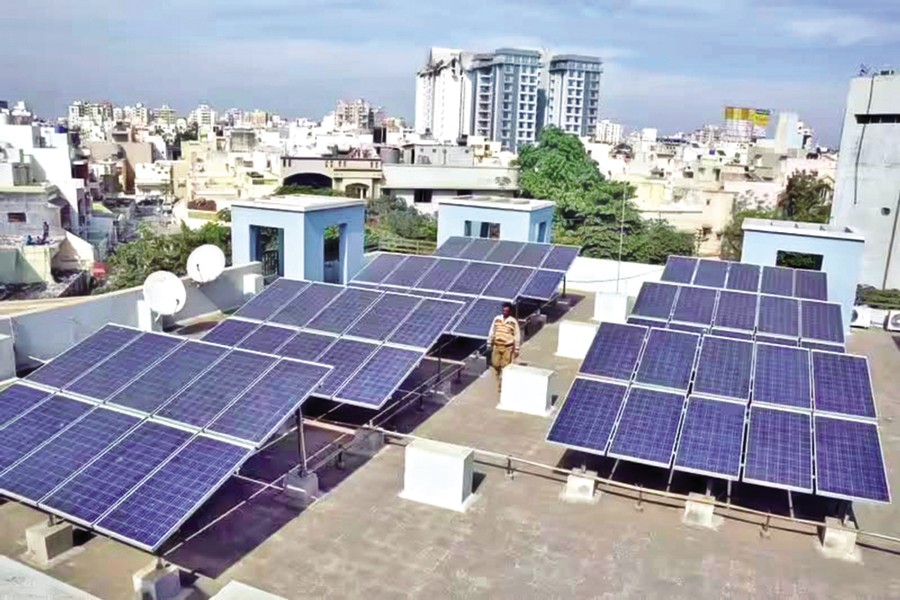
Published :
Updated :

A leading energy think-tank has raised doubts over whether Bangladesh can rapidly scale up rooftop solar capacity to 3,000 megawatts (MW) by December this year, citing limited institutional capacity and financing challenges.
The Institute for Energy Economics and Financial Analysis (IEEFA) also flagged regulatory bottlenecks and implementation delays that could undermine progress, potentially requiring an extension of the ambitious deadline.
The government's target is more than twelve times the country's current installed rooftop capacity of just 245MW.
Announced in the midst of Bangladesh's deepening energy crisis, the initiative has been welcomed as a timely push for renewables.
However, the IEEFA briefing note questions whether such a steep scale-up is overly ambitious and feasible given the existing constraints.
The think-tank, which analyses energy markets, trends and policies, reiterated its mission to accelerate the shift towards a diverse, sustainable and profitable energy economy.
"As government offices, hospitals, educational and religious institutions are unlikely to offer adequate sanctioned load to install 3,000MW rooftop solar, the Sustainable and Renewable Energy Development Authority (SREDA) should assess and document rooftop solar potential in these buildings," says Shafiqul Alam, IEEFA's lead energy analyst for Bangladesh and the author of the note.
"Furthermore, fund allocation for various projects, tendering, evaluation of bidding documents, issuing work orders and project implementation will likely require an extension of the December 2025 deadline," adds Alam.
The note highlights that only 15-20 high-quality engineering, procurement and construction companies operate in the country, and they may not have enough capacity to install 3,000MW in less than six months.
Under Bangladesh's new rooftop solar programme, government offices will roll out installations via the capital expenditure (CAPEX) model supported by public funds, while hospitals and educational institutions will operate under the OPEX model with no upfront cost.
While the CAPEX model allows for faster rollout and higher savings, there could be risks stemming from poor coordination, lack of maintenance, and rushed developer selection.
On the other hand, the operational expenditure (OPEX) model ensures quality, but offers lower savings, and could face financing hurdles and risks from load-shedding in rural areas. If projects are small and scattered in rural areas, they may fail to attract companies to invest in the OPEX model," he says.
It highlights the risk of soiling that could significantly reduce solar energy yield per annum and calls on the government to instruct public offices to create a fund from the monthly savings in projects under the CAPEX model and enter long-term maintenance contracts with service providers.
It also underscores that utilities should find a way to address load-shedding in rural areas, as the resulting solar generation loss could pose risks under the OPEX model.
Bangladesh can draw on the experience of its neighbouring countries like India, Pakistan and Sri Lanka, which boast of a greater share of renewable energy in the power mix, ranging from 47 per cent to 63 per cent, the note suggested.
For instance, Pakistan's rooftop solar sector success is an example that push factors, such as energy supply crunch and unaffordable power tariffs, can spearhead change, it added.
In Sri Lanka, the government addressed financing barriers to expand rooftop solar, supported by a multilateral agency.
The government later provided funds for rooftop solar on public buildings. Similarly, India's rooftop solar capacity of more than 18 gigawatts in May 2025 can be attributed to the consistent policy and regulatory support extended by the government.
"As Bangladesh's rooftop solar sector is still at a nascent stage, capacity development of key stakeholders and government agencies will be important for the programme's success. Besides, the government should establish an independent monitoring mechanism to ensure that projects operate smoothly," the note suggested.
The Institute for Energy Economics and Financial Analysis (IEEFA) examines issues related to energy markets, trends, and policies. The Institute's mission is to accelerate the transition to a diverse, sustainable and profitable energy economy.
Azizjst@yahoo.com


 For all latest news, follow The Financial Express Google News channel.
For all latest news, follow The Financial Express Google News channel.